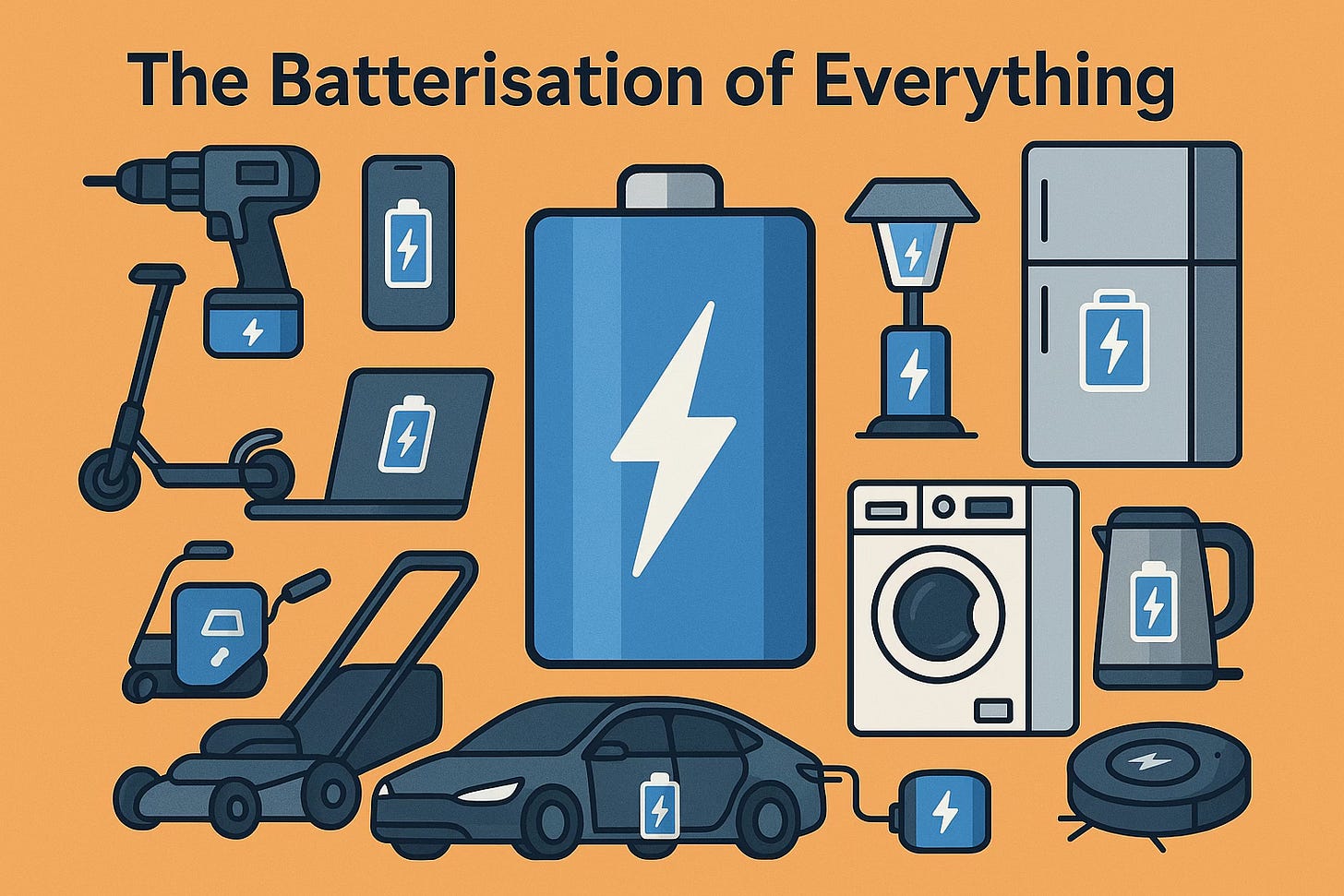The Batterisation of Everything
We are entering a new era, one in which everything that moves, heats, cools, lights or connects is being fitted with a battery. It started with our phones and laptops. Then came drills, scooters, lawn mowers, cars, and even garden lamps and doorbells. Next up? Washing machines, fridges, kettles, heat pumps and robots. This is the batterisation of everything. And it’s a much bigger deal than most people realise.
This revolution is being driven by two big forces. First, battery prices have collapsed. Lithium-ion battery packs costs, which is the premier battery technology, have fallen 89 percent since 2010, from $1,200 per kilowatt hour to circa $130 today. Second, performance keeps improving. Energy density is rising 5 to 8 percent every year. The result is exploding demand. Global lithium-ion battery production hit 700 gigawatt hours last year, up from just 59 gigawatt hours in 2015. And those cost and performance improvements are going to continue in the coming years.
At the surface, this trend to batterisation is about convenience. We want to have cheap and secure power for the multitude of digital devices that make up our modern lives. But dig deeper and it is about a fundamental rewiring of the energy system. We are moving from dumb appliances that only consume power to smart devices that can store and manage it. Take LG’s ThinQ washing machines. They can already delay their cycles to run when electricity is cheapest. The next generation will probably come with batteries, allowing them to switch on when solar is abundant or prices drop. Fridges will ride through short power cuts. The best products will not just work well. They will quietly save users money. And as battery and connectivity costs keep falling, we will see batteries in more places. Homes will become power plants. Offices will become energy hubs. Robots will become commonplace.
The biggest game changer will be electric vehicles. An average EV battery holds 60 to 100 kilowatt hours. That is enough to power a home for a few days. These batteries will soon power more than cars. They will power houses and even feed energy back to the grid. Vehicle to grid and vehicle to home technologies are coming faster than most expect. In the UK, Octopus Energy just launched the first mass market vehicle to grid tariff. EV owners can now earn up to £850 a year just for feeding electricity back. These are early days but this is where the market is going. Cars will become both a mobility asset and an energy asset and within five years, EVs could become the single largest source of flexible and backup power capacity in the global power system.
Multiply that across millions of homes and appliances and suddenly you have a new layer of flexibility built right into the global power system, all of which saves customers money and increases the stability and resilience of the whole system.
The batterisation of everything has huge implications. This is not just a shift in technology. It’s a redesign of the entire energy landscape. The battleground of the energy transition is no longer just in power plants and grids. It’s in your car, your garage, your kitchen, your office. Batteries are turning end users into active players. Energy will be bought, stored, shared and sold in new ways. The winners? Those who manage it best.



Gerard, this is brilliant. I realized during the London ETF that batteries can provide the grid and its customers with almost all the services it ever requires: supply, demand, power quality, voltage support, frequency support, pseudo-inertia, demand-response, peak-shaving, black-start power, outage response. The one service still missing is the ability to store power to deal with long-term (seasonal) demand variations, for which no current commercial battery chemistry offers a solution. Iron-oxide batteries (power from rusting iron) may offer the low-cost commodity economics required for that remaining need.
https://www.mdpi.com/2313-0105/10/1/38?utm_source=chatgpt.com